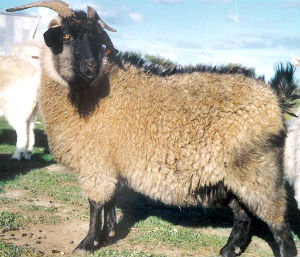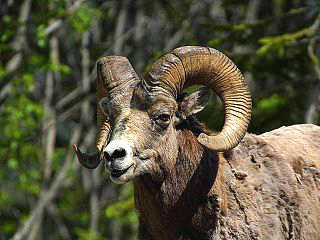Goat × Bighorn Sheep
Capra hircus × Ovis canadensis
Mammalian Hybrids
EUGENE M. MCCARTHY, PHD GENETICS, ΦΒΚ
This cross is related to goat × sheep and goat × chamois.
In 1877, Colorado rancher C. H. Storkstomer described how he serendipitously produced hybrids between bighorn ewes and domestic cashmere goats. He claims the resulting hybrids, which were considerably larger than either of their parents, went on to produce three-way hybrids with domestic cattle. Since it seems that no other, more recent, reports mention such a hybrid, Storkstomer’s claims must be taken with a grain of salt.
He describes his experience in an article, which was originally published in the St. Louis Globe-Democrat , and which is here transcribed from The Findlay Jeffersonian a newspaper in published in Findlay, Ohio. It appeared in columns 1 and 2 of page 2 of the June 8, 1877, issue of that publication (source). It reads as follows (typos corrected and paragraph breaks added for readability):
CROSSING BREEDS
A Hybrid That Gives Milk Like an Alderney and Sheds Fleece Like a Cashmere—Curious Amalgamation of the Domestic Goat, Mountain Sheep and Common Cow.
Correspondence of Globe-Democrat.
"Casa Blanco," Rio Grande River, Mouth of Snowy Canyon, Col., Feb. 10, 1877.— In looking over a late copy of the Globe-Democrat, I saw an article copied from the Turf, Field and Farm relating to the cross between the native cow and the buffalo, or the American bison. I also saw a similar article in the Ohio Farmer some time ago mentioning the successful crossing of the native cow with the buffalo, and detailing at considerable length the effect of the cross, the writer being more than satisfied with the experiment.
I have been largely interested in stock raising in the southwestern part of Colorado for the past seventeen years, and during the early years of my experience quantity was our object, as our pasturage was abundant, our winters mild, and no trouble from Indians. I soon increased my herds to 5000 sheep and 1200 head of cows, with their increase, standing at this for several years.
But during the late years I readily saw that it was important to improve out stock and reduce the quantity. So during the year 1870 I had sent to me from New York State a few choice Alderney cows and bulls [Alderney was apparently another name used at that time for Guernsey.]; also fine Cashmere goats (of the male persuasion), all of which I proceeded to introduce into my herds immediately. The effect of the goats on my sheep was miraculous, but my Alderney blood seems to lose itself in my Mexican stock.
About this time one of my rancheros brought in from the mountains two young lambs of the mountain sheep species, or big horns of the Rocky Mountains. I took all possible care of them, and soon they were running about the place, seemingly perfectly domesticated, skipping over the rocks in the vicinity, also our stables, houses, etc., with more fearless bravado than even our native or domestic goat displays, getting so troublesome that I had them penned up with my Cashmere goats, which they acquired a fondness for, and, greatly to my surprise, when the proper season came took to my buck Cashmeres as did the other sheep (for they were both ewes) and in the spring following one dropped twins and the other one kid, or lambs, as you please to call them, and judge of my joyful surprise when I discovered in them all the principal characteristics of the goat. Now I was becoming interested indeed. This new species of sheep or goats grew rapidly, and as the season advanced I saw they were going to be considerably larger than either the goat or sheep, which are both quite large, you know. I now endeavor to keep up the cross, so I keep a buck with my two ewes, and in the spring I got two pair twins.
The yearlings now had not received the services of the buck, and they were so troublesome with the kids that I shut them up in my corral where I had my blooded Alderney calves. Leaving home about this time and not returning for some months, I immediately upon my arrival took the then yearlings past in hand and attempted to get them served with one of my bucks, but no go. One of my men said he had seen the calves (which were yearlings past) fooling with the two ewes. I suspected I would lose the services of the two ewes, or that, as in the case with other crossed things, as mules, and geese after being crossed with the wild geese, the breeding had stopped.
But wonders, as misfortunes, never come singly. I discovered to my astonishment that they were all right; you can guess now of my interest to see the kids. I almost neglected other things to take care of these two ewes. The time expired as I thought, and no kids [The mean gestation period of a goat is 150 days, that of a bighorn sheep, 177, of a cow, 274 days. Since the gestation period of a hybrid is usually the average of the gestation periods of its parents, the expected period here would be ((150+177)/2)+274)/2 = 219 days] but as I could see that they were well and hearty, I awaited patiently, and one soft morning I found two new arrivals. The climax had come. The little fellows were as lively as kittens, but, O heavens! What were they? They were not lambs; they were not goats.
Well to tell the plain unvarnished truth, they were another cross. It was now between my Alderneys and the already hybrids [i.e., and the F1 cashmere goat × bighorn hybrids]—and twins, too! After a few days the other came in, and the same freak of nature had occurred, and this time there were three heifers and one male calf, kid, or lamb—they had now gone so far that I dare not say which.
My other two came in all right, with twins apiece the same as the first. I don't pretend to explain the reasons of the crosses, only this much: The first crosses were a third larger than a sheep or goat, which are both nearly twice as large as small sheep. I determined to test the matter, to see whether it was a freak or in the order of things that they took my bull. So I shut up, at the proper time, the two first crosses with my bull, and the result was they are now carrying their young.
A singular peculiarity of the last cross [(goat x bighorn) x bull] is that they still have the long fine hair of the cashmere goat, softened down somewhat by the cross with the mountain sheep. Also the hind quarters and general shape (except the horns) of the Alderney, even to the udder and spread of hips, and their teats are now, at yearlings, larger than some of my Mexican cows' teats. The horns, however, retain the peculiarity of the mountain sheep, being curved and tremendously large.
I clip the older crosses, and shall do so with last as soon as they are old enough. The wool is much softer than the original goats' wool; the length is quite as great.
I think I have got an animal now nearly as large as the ordinary Alderney, which preserves the milk giving qualities of the Alderney; also combines the wonderful fleece of the cashmere goat, increased in size, and undoubtedly bettered by the hardihood of our native mountain sheep. These [bighorn] sheep are said to be the chamois of America, and are said to be equal in flavor to those of our Southern climates. They are celebrated for this here with all our hunters and frontiersmen.
I will if I obtain, which I think I have, the milking qualities of the Alderney, give the matter to some scientific man and let him explain, if he can, why the cross has not been made heretofore, or by what system of circumstances I have been able to obtain it. I certainly staggered on it.
Taking into consideration the fact that they bear twins each year, it seems to me that by a little judicious management they can be increased sufficiently to be set all over the United States. But I don't think the peculiarity of the mountain sheep would thrive unless in a very high altitude—ours being 7500 feet above the sea—and it certainly improves the goat. I would like, if I had assurances of good treatment, to place a pair of the last cross in one of the city parks, for a season, to see if they would acclimatize. I will send you some of the wool.
I am organizing an expedition now to go into the mountains and capture mountain sheep this spring; there are large quantities of them near my place.
Respectfully,
C. H. Storkstomer
By the same author: Handbook of Avian Hybrids of the World, Oxford University Press (2006).
Most shared on Macroevolution.net:
Human Origins: Are we hybrids?
On the Origins of New Forms of Life
Mammalian Hybrids
Cat-rabbit Hybrids: Fact or fiction?
Famous Biologists
Dog-cow Hybrids
Georges Cuvier: A Biography
Prothero: A Rebuttal
Branches of Biology
Dog-fox Hybrids
 Cashmere goat
Cashmere goat Bighorn Sheep
Bighorn Sheep